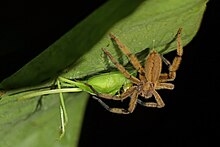| Cupiennius | |
|---|---|

| |
| Adult male Cupiennius salei in northern Honduras | |
| Scientific classification | |
| Domain: | Eukaryota |
| Kingdom: | Animalia |
| Phylum: | Arthropoda |
| Subphylum: | Chelicerata |
| Class: | Arachnida |
| Order: | Araneae |
| Infraorder: | Araneomorphae |
| Family: | Trechaleidae |
| Genus: | Cupiennius Simon, 1891[1] |
| Type species | |
| C. getazi Simon, 1891
| |
| Species | |
|
11, see text | |

Cupiennius, known by the common name bromeliad spiders or as the often confused name banana spiders,[2] is a genus of araneomorph spiders in the family Trechaleidae, named by Eugène Simon in 1891.[3] They are found from Mexico to northwestern South America, and on some Caribbean islands. Unlike the dangerously venomous Phoneutria, bites from these spiders typically have only minor effects on humans, and have been compared to a bee sting.[4]
Members of this genus come in a range of sizes, from cephalothorax lengths less than 9 mm (0.35 in) to large species, with a cephalothorax length of 40 mm (1.6 in).[4] The larger species are sometimes found far outside their native ranges in shipments of fruits, where they are frequently confused with Phoneutria spiders.[2]
- ^ Cite error: The named reference
NMBEwas invoked but never defined (see the help page). - ^ a b Vetter, R.S.; Crawford, R.L.; Buckle, D. J. (2014). "Spiders (Araneae) Found in Bananas and Other International Cargo Submitted to North American Arachnologists for Identification". Journal of Medical Entomology. 51 (6): 1136–1143. doi:10.1603/me14037. PMID 26309299. S2CID 27097945.
- ^ Simon, E. (1891). "Descriptions de quelques arachnides du Costa Rica communiqués pa M. A. Getaz (de Genève)". Bulletin de la Société Zoologique de France. 16: 109–112.
- ^ a b Vetter, R.S.; Hillebrecht (2008). "On distinguishing two often-misidentified genera (Cupiennius, Phoneutria) (Araneae: Ctenidae) of large spiders found in Central and South American cargo shipments". American Entomology. 54: 82–87.